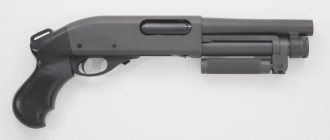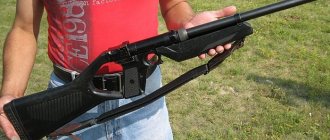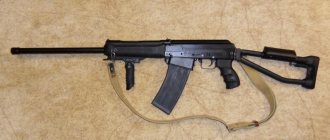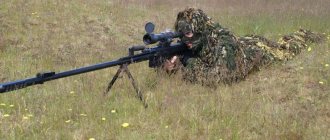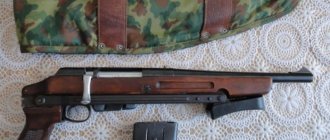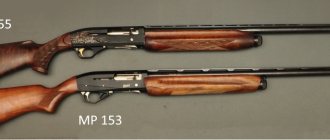Having become a worthy continuation of its parent, the Kalashnikov assault rifle, the Saiga 12 smoothbore shotgun has established itself as one of the most powerful and reliable examples of self-loading weapons. At the same time, having a civilian purpose, the Saiga 12 carbine, if desired, can easily be used as a powerful assault weapon.
Thanks to this quality, this weapon was officially adopted by the Ministry of Internal Affairs of the Russian Federation and Kyrgyzstan, Indonesia purchased a large batch of these carbines for the National Drug Enforcement Agency, the United States purchased it for police units and its army until 2014, and Ukraine armed it with Saiga in 2009 their naval forces.
History and background to the creation of the Saiga 12 smoothbore shotgun
Surely few hunters and gun lovers have thought about why one of the most popular guns among hunters of the former USSR was called the steppe antelope? We are talking about the Saiga smoothbore hunting rifle and, in particular, one of the first models - Saiga 12. Meanwhile, the story is interesting.
In the relatively recent 1970s, in the vastness of Kazakhstan, without the slightest exaggeration, thousands of herds of saiga grazed, literally stripping the steppe of grass during migration, simultaneously eating and trampling large crops of grain. The quickly created detachments of hunters, armed only with hammer-fired hunting rifles, had no influence on the situation at all.
This forced the then First Secretary of the Central Committee of the Communist Party of Kazakhstan, Dinmukhamed Kunaev, to turn to the General Secretary of the CPSU Central Committee, Leonid Brezhnev, with a tearful request to create a weapon that would radically reduce the number of saigas.
It took Izhmash designers and testers four long years to create and perfect the new weapon. Its first version, the Saiga 410 smoothbore shotgun, according to many experts, was very far from perfect, but in the late 90s, gunsmiths showed the world, created on the basis of the same Kalashnikov assault rifle, the Saiga 12 smoothbore carbine, which uses the 12 hunting cartridge th caliber.
The new weapon, the Saiga 12 smoothbore shotgun, has become one of the most powerful examples of self-loading weapons, which can be used both in shooting sports and hunting, and as a powerful assault weapon. Its combat version was called the 18.5 KS-K carbine.
[edit] Cleaning and lubrication
Cleaning should be done using the accessory included with the carbine no later than one day after shooting. In winter, cleaning is carried out indoors with an air temperature of 20°±5°C after the carabiner has warmed up to room temperature. To clean the barrel bore and chamber, use clean wiping material (rags, tow) free of sand and solid particles. Cleaning is carried out in the following sequence:
- Lubricate the bore and chamber with a brush, dipping it in RJ or VO oil
- Wipe the barrel bore dry using a wiper with a wiping material tightly wrapped around it;
- Repeat the process of lubrication and wiping 8-10 times until carbon deposits are completely removed (checked by inspecting the bore)
- After marking, lubricate the barrel bore and chamber with clean RZh
or
VO
.
To ensure normal operation of the carbine, it is necessary to promptly remove carbon deposits from the gas chamber, gas tube and gas piston of the bolt frame.
Lubrication should be carried out depending on temperature conditions in accordance with. Thickening of the lubricant in the bolt channel under the firing pin, in the socket under the ejector and on the mainspring is unacceptable.
Adjusting the accuracy of shooting from an open sight.
If necessary, the shooting accuracy can be adjusted by moving the base of the front sight to the right and left and rotating the front sight up and down. When the base of the front sight moves by 1 mm, the point of impact of the bullet shifts by 200 mm. When the front sight is rotated by 1 turn, the point of impact shifts by 150 mm. Sighting is carried out at a distance of 100 m.
[edit] Adjusting the optical sight
The optical sight of the carbine is zeroed at 100 m, and the scales are set to “0”. If you are not satisfied with this zeroing, it is necessary to zero the optical sight again at the open sighting device, for which:
- install the clamp of the open sighting device on division “1” of the sighting bar;
- place the carbine on the rest and aim the open sight at some point at a distance of 100 m;
- check the position of the aiming stud of the optical sight relative to the aiming point, if there is a mismatch, align them by rotating the handwheels without moving the carbine;
- check the adjustment made by shooting.
If the deviation of the holes from the aiming point is not satisfactory in terms of accuracy, enter corrections by rotating the handwheels (one large division of the handwheel scales corresponds to an correction of one thousandth of the distance), and then set the scales to division “0”. To do this, carefully loosen the scale fastening screws, align the “0” mark on the lateral correction scale and the “0” mark on the distance scale with the fixed pointers on the sight body, and tighten the scale fastening screws. In this case, turning the handwheels is not allowed.
If it is necessary to zero the optical sight at other distances, then zero it by rotating the distance handwheel. On the distance scale opposite the pointer, mark the marks corresponding to the distances, and write down the scale values in the table.
| Distance, m | 100 | 200 | 300 | 400 | 500 |
| Scale division |
In fairness, we must still admit that despite all the reliability and trouble-free operation, the accuracy of the Saiga carbine
leaves much to be desired.
Fishermen noted that if when shooting within 50-70 meters the accuracy was quite acceptable, then at a running antelope or mountain goat at a distance of more than 100 meters the chances of making an accurate aimed shot were very small. Despite its affordability, Saiga
began to experience strong competitive pressure from Vepr.
An analysis carried out by Izhmash specialists showed that the Saiga’s
was quite predictable. Indeed, it was difficult to expect sniper accuracy from a weapon developed on the basis of an assault rifle, where accuracy, although it plays a certain role, is not a decisive factor. Therefore, Izhmash studied the needs of hunters who wanted to have an inexpensive, reliable weapon that would allow more accurate shooting at longer distances when developing the Saiga-308 model.
Design features of the Saiga-12 smoothbore shotgun
The difference between the Saiga 12 smoothbore shotgun and military weapons is that it was originally intended to fire single shots. It does not have a self-timer mechanism, and there is also no retarder in the trigger mechanism of the carbine. The trigger, sear, and safety switch have been modified; cartridges are fed differently from the magazine to the chamber.
In order to exclude the possibility of using a machine gun magazine with live ammunition in the carbine, the assembly of its attachment to the weapon has been changed. The butt and fore-end of the carbine are like those of hunting rifles, but may be the same as those of a Kalashnikov assault rifle. There are also options for a frame stock, like the AKS-74.
Weapon device
The Saiga self-loading hunting carbine is as simple and reliable in design as the Kalashnikov assault rifle. This sets this weapon apart from other competitors, which are often very difficult to understand, having many small parts in their design.
Design
Like the AK, the Saiga 410 does not have a “classic” solid stock. Taking into account the durable receiver, the separate butt and forearm help to hold the weapon when shooting. The barrel bore is locked in a manner familiar to many gun enthusiasts: the bolt rotates around its axis, resulting in longitudinal sliding of the bolt frame.
The trigger mechanism (Trigger Mechanism) is a trigger mechanism, it allows you to fire single shots and install the safety lock on the carbine. The carbine's gas engine can be adjusted. This is done by changing the stub modes.
Currently, all modifications of the Saiga-410 are equipped with a dovetail side rail, located on the left side of the receiver and similar to the rails on the AK-74M assault rifles. This rail can be used to mount additional sighting devices on the side bracket (usually optical, collimator sights, night vision sights).
To install the necessary attachments, the Saiga barrel is equipped with a special thread. The nozzles differ from each other in the amount of narrowing. The effectiveness of shooting depends on them: accuracy and accuracy. The worst results are achieved when shooting without attachments; the best results are obtained when using a choke attachment. When using factory ammunition, it is recommended to use smooth nozzles. “Paradox” is considered one of the best; it improves accuracy when firing bullets more effectively than others.
Principle of operation
The trigger is placed in the firing position, secured by the cocking sear, and the cartridge is sent into the chamber. After pressing the trigger guard, the cocking sear is released, and the mainspring provides the firing pin with the necessary inertia to activate the primer. This is how the shot is fired.
To reload the weapon, the energy of the return spring and powder gases entering the gas chamber from the barrel are used. Under the influence of powder gases, the bolt frame, moving to the rear position, removes the spent cartridge case from the chamber, and it is thrown out by the reflector.
The gas chamber plug of the carbine allows you to regulate the pressure of the powder gases in two modes. The first is standard, the second increases pressure. With constant use of the second position, for example, to speed up the ejection of a spent cartridge case, the wear of parts increases and the survivability of the carbine decreases. But if during shooting you feel increased recoil to the shoulder, it is better to move the plug to the first position.
Rules of application
The use of the carbine should be divided into three stages:
- Preparation for shooting;
- Firing shots;
- Transferring the weapon to a “stowed” state.
At the first stage you should:
- Make sure the weapon is clean, and remove any remaining grease from all metal surfaces;
- Prepare the aiming device. If there is a front sight, smoke it; if there is an optical sight, check the cleanliness of the lenses, if necessary, clean with a soft rag or special wipes;
- Install the existing optics in their regular place;
- Check the operation of parts and mechanisms in an uncharged state.
Before shooting begins, the magazine is equipped with ammunition and attached to the carbine. Loading the cartridge is accompanied by retracting the bolt to the rear extreme position and releasing it without hand movement. After this, the carbine is considered ready for shooting.
After detecting the target, the weapon is released from the safety lock and aimed fire is carried out from it. Upon completion of shooting, the following actions must be taken:
- Check the installation of the weapon on the safety device;
- Disconnect the magazine;
- Remove the fuse;
- Place the bolt carrier in the rear position, make sure that there is no cartridge in the chamber, and return the bolt to its normal position;
- Fire a test shot, then reinstall the safety;
- Remove and unload the magazine.
Saiga in action
Storage and care
The reliability and efficiency of a weapon largely depends on its proper maintenance and timely maintenance. It is recommended that Saiga-410 carbines be thoroughly cleaned no later than 24 hours after shooting. In addition, if the shooting was very active, then it is highly advisable to clean the bore after 50 shots.
Cleaning of the carbine is organized at an ambient temperature of plus 15-25 ° C, that is, in cold weather - in rooms warm enough for this. Cleaning is carried out on the basis of incomplete disassembly of the weapon, using accessories from the kit included with it, clean rags and gun lubricant. The recommended sequence includes, in particular, the following main steps:
- Using a brush moistened with lubricant, the barrel channel, chamber, and exhaust gas chamber are cleaned. The cleaned surface is wiped with a clean rag. The process is repeated until the carbon deposits are completely removed;
- Carbon deposits and the consequences of the activity of powder gases are removed from the structural elements of the trigger mechanism with rags and lubricant. A thin layer of lubricant is simultaneously applied to the same surfaces;
- The surface part of the weapon is cleaned, then wiped with a semi-dry cloth;
- The store is being partially dismantled. Dirt and plaque are removed and lubrication is performed.
The carbine is stored after thorough cleaning in special, rigidly secured metal cabinets, separate from the ammunition. Compliance with storage requirements will be periodically verified by authorized employees of the state licensing and permitting system.
Layout of the Saiga 12 smoothbore shotgun
This is a gas release mechanism and locking by turning the bolt. The bolt group and receiver are adapted for use in hunting cartridges. That is, the trigger does not have a self-timer.
The gas release mechanism is equipped with a gas regulator and this ensured firing with conventional and reinforced magnum cartridges. Some Saiga models are equipped with Picattini rails to equip the weapon with additional equipment (collimator sights, flashlights, etc.).
The gun's automatic system is as versatile as possible, which makes it possible to use traumatic cartridges and cartridges with a double rubber bullet.
A variety of sighting equipment can be easily installed on the Saiga.
In the basic configuration, the carbine has a specially designed muzzle attachment that acts as a flash suppressor and allows the use of special ammunition to destroy door locks, hinges and other obstacles.
Ammo for Saiga 12
The 12 gauge Saiga smoothbore shotgun uses two types of cartridges. Regular 12x70 and reinforced Magnum type. To use this ammunition, the gas release mechanism must be adjusted correctly. It has a regulator with two positions used when firing one of the two ammunition.
It is necessary to take into account that if cartridge cases have even slight deviations from the standard ones, this creates problems when removing them from the magazine.
Saiga shotgun 12 gauge specifications
| Characteristic name | Models and meaning of characteristics | ||
| Saiga 12 | Saiga 410 | Saiga 20 | |
| Ammunition | 12x70/12x76 | .410 | 20 |
| Total length of weapon, mm | 1145 | 1170 | 1135 |
| Barrel length, mm | 680 | 570 | 570 |
| Weapon width, mm | 70 | 70 | 70 |
| Weapon height, mm | 190 | 190 | 190 |
| Gun weight, kg | 3,8 | 3,4 | 3,5 |
| Magazine capacity | 2/4/5/8 | 8 | 2/5/8 |
Disassembly and assembly of the Saiga 12 carbine
- If present, turn the bracket handle 180 degrees, moving backwards, first remove the optical sight.
- Pressing the lever on the rear wall firmly, remove the receiver cover.
- Remove the return mechanism.
- Pull it back as far as it will go and remove the bolt frame together with the bolt upwards.
- To separate and remove the bolt from the frame, turn it up as far as it will go.
- The pin holding the gas chamber plug must be driven in with a drift and unscrewed in a counterclockwise direction.
- Remove the piston.
- Unscrew the retaining screw and disconnect the handguard.
Assembling the parts of the Saiga 12 smoothbore shotgun is carried out in the reverse order.
[edit] Device
The carbine consists of the following main 1 vicious units: a barrel with a receiver; bolt frame with bolt; gas engine; return mechanism; trigger mechanism; butt; forend; gas tubes; open sighting device; optical sight with bracket. The receiver has a base for mounting an optical sight bracket.
The barrel is 520 mm long (105 mm longer than the machine gun barrel), the barrel bore and chamber are chrome-plated. Automatic reloading of the carbine is carried out by using the energy of the powder gases removed from the barrel bore into the gas chamber, and the energy of the return spring. The bolt is locked onto two lugs by rotating the bolt around its axis using a longitudinally sliding bolt frame. The hammer-type trigger mechanism ensures the production of a single shot and the safety lock, which blocks the trigger. Turning the fuse on and off is carried out by moving its flap up to down. Protection
and down to
the Fire
. The days of firing the next shot, you must release the trigger and press it again. The magazine is detachable, box-shaped, in the middle for 5 and 10 rounds. When the magazine runs out of cartridges, the moving parts will remain in the forward position. To continue shooting, you need to change the magazine, pull the moving parts back until they stop and release.
Unlike its combat prototype, the Saiga
An elongated forend without a receiver lining was used. At the same time, the gas chamber tube is of a new design, taking into account the design requirements.
An open sighting device and an optical sight allow targeted shooting at distances of up to 300 m. The design of the front sight assembly has been changed - it is borrowed from the Los-7 carbine. The front sight is adjustable horizontally and vertically, which allows you to target the weapon individually for each hunter. Installation of the open sight in a position corresponding to the firing distance is driven by the sighting bar clamp. Thus, position “3” of the clamp corresponds to a distance of 300 m, positions “2” and “1” - 200 and 100 m, respectively.
The optical sight is mounted on a bracket, the design of which allows you to fire from an open sight without removing the optical sight. The bracket for mounting an optical sight is designed specifically for the Saiga
, it allows you to place the PO-3.5 or PO-4x34 sight, produced by the LOMO association. Another bracket is currently in development, which will allow the installation of any optical sights with a standard mounting diameter of 1 inch (or 26 mm) on the carbine. At the same time, the bracket provides the possibility of horizontal and vertical adjustment for preliminary alignment of the sight on the weapon. It is also possible to install the NSPUM night sight.
To attach an optical sight to a carbine, you need to turn the bracket handle 180° so that the end of the handle is positioned towards the eyepiece, then push the sight bracket onto the base lug of the receiver until it stops and turn the handle back. Then check the tightness of the bracket by rocking the scope sideways with your hand. If there is motion, remove the handle latch and move the handle one tooth clockwise until the scope motion is eliminated, then install the latch and again check the tightness of the optical sight bracket screws.
The overall dimensions of the carabiner in length, width and height are no more than 1070, 70 and 220 mm, respectively. The weight of the carbine with a five-place magazine (without an optical sight, accessories, case with belt) is no more than 3.6 kg.
To keep the carbine in working order, it must always be cleaned and lubricated with a thin layer of gun oil. The rifle should be stored in a dry room, without sudden temperature fluctuations, away from heating devices and in the absence of aggressive impurities in the surrounding air. To avoid permanent deformation of the mainspring, the hammer must be released.
Modifications of the Saiga shotgun
The main ones, besides the Saiga 12 model, are the Saiga 410 and Saiga 20 modifications.
Saiga 410 is a self-loading smoothbore carbine, manufactured in 1993. Designed for commercial and amateur hunting of small and medium-sized animals and birds. The ammunition for this weapon was the .410x76 mm R cartridge.
“Saiga 12C” is a modification with a folding plastic stock, a fire control mechanism similar to Kalashnikov assault rifles, and a handguard for commercial hunters.
“Saiga-12K” is a short-barreled version of the carbine, equipped with a folding shoulder rest and handle similar to Kalashnikov assault rifles, as well as a shot blocking device when the butt is folded.
“Saiga-12S EXP-01” is an export version of “Saiga-12K” (without a trigger mechanism locking device).
Saiga 20 is a self-loading gun for commercial and amateur hunting of small, medium-sized animals and birds in areas with any climatic conditions. The weapon uses 20 gauge cartridges.
Performance characteristics
Cartridges and caliber
In the name of the Saiga carbine, the 410 caliber reflects the system of its measurement in inches, adopted in the United States. According to the metric system of measures, this corresponds to a caliber of 10.4 mm, which is considered a very small value for shotguns. Classic hunting cartridges with a case length of 70 millimeters for this caliber show low efficiency. Therefore, hunting a medium-sized animal requires the use of more powerful cartridges with a 76 mm sleeve.
The use of shot and buckshot in this case is also not recommended due to their low efficiency. Moreover, even bullet ammunition, due to the use of a smooth barrel, is limited in firing range and power.
Dimensions, weight, length
| Options | Values for various modifications | |||||
| Saiga-410 | 410С | 410K | 410K-01 | 410K-02 | 410K-03/04 | |
| Weapon length (including with folded stock) | 1170 mm | 1080 (840) mm | 840 (595) mm | 910 (670) mm | 910 (670) mm | 825 (585) mm |
| Barrel length | 570 mm | 570 mm | 330 mm | 404 mm | 404 mm | 351 mm |
| Weight without cartridges | 3.4 kg | 3.4 kg | 3.2 kg | 3.1 kg | 3.3 kg | 3.2 kg |
Store capacity
The Saiga 410 detachable single-row box magazine can hold 2, 4 or 10 rounds. At the same time, the standard equipment of the basic version of the carbine usually includes 4-round magazines, and 10-round magazines are supplied for later modifications, starting with version 01, but options with 2-round magazines are not provided for them.
Firing range and lethal force
The effective firing distance from this weapon when using shot is 25 meters. The use of bullets increases this figure to 50 meters. In general, the firing characteristics of the Saiga 410 carbine in terms of range and accuracy largely depend on the specific type of ammunition used. The best options for bullet cartridges are Federal and Remington, the use of which ensures maximum firing range.
The main elements of the Saiga carbine

